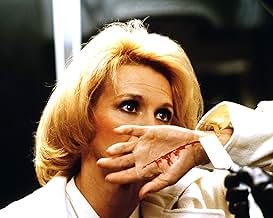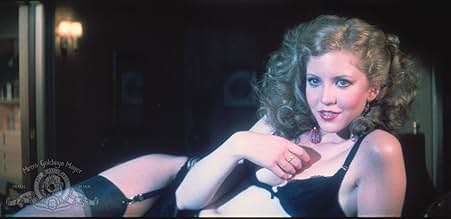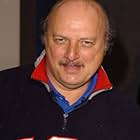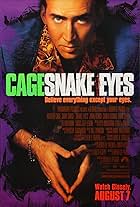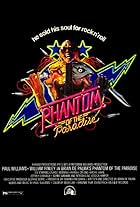A mysterious blonde woman kills one of a psychiatrist's patients, and then goes after the high-class call girl who witnessed the murder.A mysterious blonde woman kills one of a psychiatrist's patients, and then goes after the high-class call girl who witnessed the murder.A mysterious blonde woman kills one of a psychiatrist's patients, and then goes after the high-class call girl who witnessed the murder.
- Awards
- 1 win & 10 nominations total
Anneka Di Lorenzo
- Nurse
- (as Anneka De Lorenzo)
- Director
- Writer
- All cast & crew
- Production, box office & more at IMDbPro
Storyline
Did you know
- TriviaAngie Dickinson said the scene where her character gets seduced in the back of a taxicab was filmed on-location in New York City, where several gawkers observed the scene and shouted, "Right on, Police Woman!" (referring to her previous television role as the title character on Police Woman (1974)).
- Goofs(at around 55 mins) Peter Miller looks in the visor of his Super 8 camera. The format of the visor is 'Cinemascope', which never has been really possible with S8. Later, when the resulting movie is seen, it is in the standard 4/3 format.
- Quotes
Liz Blake: Do you want to fuck me?
Dr. Robert Elliott: Oh, yes.
Liz Blake: Well, why don't you?
Dr. Robert Elliott: Because I'm a doctor and...
Liz Blake: Fucked a lot of doctors.
Dr. Robert Elliott: ...and I'm married.
Liz Blake: Fucked a lot of them, too.
- Alternate versionsNBC edited 14 minutes from this film for its 1982 network television premiere.
- ConnectionsEdited into Sex at 24 Frames Per Second (2003)
Featured review
Kate Miller (Angie Dickinson) is having problems in her marriage and otherwise--enough to see a psychologist. When her promiscuity gets her into trouble, it also involves a bystander, Liz Blake (Nancy Allen), who becomes wrapped up in an investigation to discover the identity of a psycho killer.
Dressed to Kill is somewhat important historically. It is one of the earlier examples of a contemporary style of thriller that as of this writing has extensions all the way through Hide and Seek (2005). It's odd then that director Brian De Palma was basically trying to crib Hitchcock. For example, De Palma literally lifts parts of Vertigo (1958) for Dressed to Kill's infamous museum scene. Dressed to Kill's shower scenes, as well as its villain and method of death have similarities to Psycho (1960). De Palma also employs a prominent score with recurrent motifs in the style of Hitchcock's favorite composer Bernard Herrmann. The similarities do not end there.
But De Palma, whether by accident or skill, manages to make an oblique turn from, or perhaps transcend, his influence, with Dressed to Kill having an attitude, structure and flow that has been influential. Maybe partially because of this influence, Dressed to Kill is also deeply flawed when viewed at this point in time. Countless subsequent directors have taken their Hitchcock-like De Palma and honed it, improving nearly every element, so that watched now, after 25 years' worth of influenced thrillers, much of Dressed to Kill seems agonizingly paced, structurally clunky and plot-wise inept.
One aspect of the film that unfortunately hasn't been improved is Dressed to Kill's sex and nudity scenes. Both Dickinson and Allen treat us to full frontal nudity (Allen's being from a very skewed angle), and De Palma has lingering shots of Dickinson's breasts, strongly implicit masturbation, and more visceral sex scenes than are usually found in contemporary films. Quite a few scenes approach soft-core porn. I'm no fan of prudishness--quite the opposite. Our culture's puritanical, monogamistic, sheltered attitude towards sex and nudity is disturbing to me. So from my perspective, it's lamentable that Dressed to Kill's emphasis on flesh and its pleasures is one of the few aspects in which others have not strongly followed suit or trumped the film. Perhaps it has been desired, but they have not been allowed to follow suit because of cultural controls from conservative stuffed shirts.
De Palma's direction of cinematography and the staging of some scenes are also good enough that it is difficult to do something in the same style better than De Palma does it. He has an odd, characteristic approach to close-ups, and he's fond of shots from interesting angles, such as overhead views and James Whale-like tracking across distant cutaways in the sets. Of course later directors have been flashier, but it's difficult to say that they've been better. Viewed for film-making prowess, at least, the museum scene is remarkable in its ability to build very subtle tension over a dropped glove and a glance or two while following Kate through the intricately nested cubes of the Metropolitan Museum of Art.
On the other hand, from a point of view caring about the story, and especially if one is expecting to watch a thriller, everything through the museum scene and slightly beyond might seem too slow and silly. Because of its removal from the main genre of the film and its primary concern with directorial panache (as well as cultural facts external to the film), the opening seems like a not very well integrated attempt to titillate and be risqué. Once the first murder occurs, things improve, but because of the film's eventual influence, much of the improvement now seems a bit clichéd and occasionally hokey.
The performances are mostly good, although Michael Caine is underused, and Dickinson has to exit sooner than we'd like (but the exit is necessary and very effective). Dressed to Kill is at least likely to hold your interest until the end, but because of facts not contained in the picture itself, hasn't exactly aged well. At this point it is perhaps best to watch the film primarily as a historical relic and as an example--but not the best, even for that era--of some of De Palma's directorial flair.
Dressed to Kill is somewhat important historically. It is one of the earlier examples of a contemporary style of thriller that as of this writing has extensions all the way through Hide and Seek (2005). It's odd then that director Brian De Palma was basically trying to crib Hitchcock. For example, De Palma literally lifts parts of Vertigo (1958) for Dressed to Kill's infamous museum scene. Dressed to Kill's shower scenes, as well as its villain and method of death have similarities to Psycho (1960). De Palma also employs a prominent score with recurrent motifs in the style of Hitchcock's favorite composer Bernard Herrmann. The similarities do not end there.
But De Palma, whether by accident or skill, manages to make an oblique turn from, or perhaps transcend, his influence, with Dressed to Kill having an attitude, structure and flow that has been influential. Maybe partially because of this influence, Dressed to Kill is also deeply flawed when viewed at this point in time. Countless subsequent directors have taken their Hitchcock-like De Palma and honed it, improving nearly every element, so that watched now, after 25 years' worth of influenced thrillers, much of Dressed to Kill seems agonizingly paced, structurally clunky and plot-wise inept.
One aspect of the film that unfortunately hasn't been improved is Dressed to Kill's sex and nudity scenes. Both Dickinson and Allen treat us to full frontal nudity (Allen's being from a very skewed angle), and De Palma has lingering shots of Dickinson's breasts, strongly implicit masturbation, and more visceral sex scenes than are usually found in contemporary films. Quite a few scenes approach soft-core porn. I'm no fan of prudishness--quite the opposite. Our culture's puritanical, monogamistic, sheltered attitude towards sex and nudity is disturbing to me. So from my perspective, it's lamentable that Dressed to Kill's emphasis on flesh and its pleasures is one of the few aspects in which others have not strongly followed suit or trumped the film. Perhaps it has been desired, but they have not been allowed to follow suit because of cultural controls from conservative stuffed shirts.
De Palma's direction of cinematography and the staging of some scenes are also good enough that it is difficult to do something in the same style better than De Palma does it. He has an odd, characteristic approach to close-ups, and he's fond of shots from interesting angles, such as overhead views and James Whale-like tracking across distant cutaways in the sets. Of course later directors have been flashier, but it's difficult to say that they've been better. Viewed for film-making prowess, at least, the museum scene is remarkable in its ability to build very subtle tension over a dropped glove and a glance or two while following Kate through the intricately nested cubes of the Metropolitan Museum of Art.
On the other hand, from a point of view caring about the story, and especially if one is expecting to watch a thriller, everything through the museum scene and slightly beyond might seem too slow and silly. Because of its removal from the main genre of the film and its primary concern with directorial panache (as well as cultural facts external to the film), the opening seems like a not very well integrated attempt to titillate and be risqué. Once the first murder occurs, things improve, but because of the film's eventual influence, much of the improvement now seems a bit clichéd and occasionally hokey.
The performances are mostly good, although Michael Caine is underused, and Dickinson has to exit sooner than we'd like (but the exit is necessary and very effective). Dressed to Kill is at least likely to hold your interest until the end, but because of facts not contained in the picture itself, hasn't exactly aged well. At this point it is perhaps best to watch the film primarily as a historical relic and as an example--but not the best, even for that era--of some of De Palma's directorial flair.
- BrandtSponseller
- Feb 20, 2005
- Permalink
Details
- Release date
- Country of origin
- Official site
- Language
- Also known as
- Vestida para matar
- Filming locations
- Production companies
- See more company credits at IMDbPro
Box office
- Budget
- $6,500,000 (estimated)
- Gross US & Canada
- $31,899,000
- Gross worldwide
- $31,899,000
Contribute to this page
Suggest an edit or add missing content






